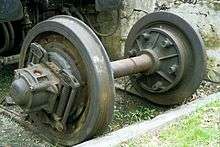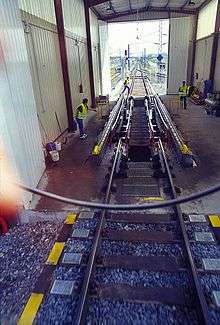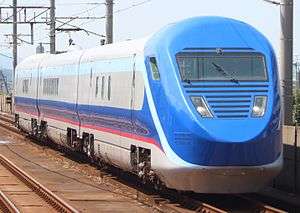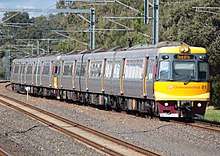Variable gauge
| Track gauge | ||||||||||||||||||||||||||||||||||||||||||||||||||||||||||||||||||||||||||||||||||||||||
|---|---|---|---|---|---|---|---|---|---|---|---|---|---|---|---|---|---|---|---|---|---|---|---|---|---|---|---|---|---|---|---|---|---|---|---|---|---|---|---|---|---|---|---|---|---|---|---|---|---|---|---|---|---|---|---|---|---|---|---|---|---|---|---|---|---|---|---|---|---|---|---|---|---|---|---|---|---|---|---|---|---|---|---|---|---|---|---|---|
| By transport mode | ||||||||||||||||||||||||||||||||||||||||||||||||||||||||||||||||||||||||||||||||||||||||
|
Tram · Rapid transit Miniature · Scale model |
||||||||||||||||||||||||||||||||||||||||||||||||||||||||||||||||||||||||||||||||||||||||
| By size (list) | ||||||||||||||||||||||||||||||||||||||||||||||||||||||||||||||||||||||||||||||||||||||||
|
||||||||||||||||||||||||||||||||||||||||||||||||||||||||||||||||||||||||||||||||||||||||
| Change of gauge | ||||||||||||||||||||||||||||||||||||||||||||||||||||||||||||||||||||||||||||||||||||||||
|
Break-of-gauge · Dual gauge · Conversion (list) · Bogie exchange · Variable gauge |
||||||||||||||||||||||||||||||||||||||||||||||||||||||||||||||||||||||||||||||||||||||||
| By location | ||||||||||||||||||||||||||||||||||||||||||||||||||||||||||||||||||||||||||||||||||||||||
|
North America · South America · Europe · Australia  |
||||||||||||||||||||||||||||||||||||||||||||||||||||||||||||||||||||||||||||||||||||||||
A variable gauge system allows railway vehicles in a train to travel across a break of gauge caused by two railway networks with differing track gauges.
For through-operation, a train must be equipped with special trucks holding variable gauge wheelsets containing a variable gauge axle (VGA). The gauge is altered by driving the train through a gauge changer or gauge changing facility.
As the train passes through the gauge changer, the wheels are unlocked, moved closer together, or further apart, and are then re-locked. Installed variable gauge systems exist within the internal network of Spain, and are installed on international links between Spain/France (Spanish train), Sweden/Finland (Swedish train), Poland/Lithuania (Polish train) and Poland/Ukraine (Polish train).
A system for changing gauge, without need for stopping is widespread for passenger traffic in Spain,[1] used in services run on a mix of dedicated high-speed lines (using Standard gauge) and older lines (using Iberian gauge).[2] Similar systems for freight traffic are still rather incipient, as the higher axle weight increases the technological challenge. Although several alternatives exist, including transferring freight, replacing individual wheels and axles, truck exchange, transporter flatcars or the simple transshipment of freight or passengers, they are impractical, thus a cheap and fast system for changing gauge would be beneficial for cross-border freight traffic.[3]
Alternative names include Gauge Adjustable Wheelsets (GAW), Automatic Track Gauge Changeover System (ATGCS/TGCS), Rolling Stock Re-Gauging System (RSRS), Rail Gauge Adjustment System (RGAS), Shifting wheelset,[4] Variable Gauge Rolling Truck,[5] track gauge change and track change wheelset.
Overview
Variable gauge axles help solve the problem of a break-of-gauge without having to resort to dual gauge tracks or transshipment. Systems allow the adjustment between two gauges. No gauge changer designs supporting more than two gauges are used.[6]
Systems

There are several variable gauge axle systems:
- Talgo-RD[7][8] (from Talgo).
- The Talgo system has been in revenue service in Portbou and Irun, on the Spanish-French border, since 1968
- It is used on the Strizh train between Moscow and Berlin.[9]
- CAF-BRAVA[7] (from Construcciones y Auxiliar de Ferrocarriles)[10][11]
- The BRAVA system was originally designed in 1968 by the Vevey Company (since absorbed by Bombardier Transportation), a company located in the city of Vevey on Lake Geneva, in Switzerland. The system was originally called the "Vevey axle".[12][13] The design was subsequently obtained and improved by Construcciones y Auxiliar de Ferrocarriles (CAF).
- DB Cargo–Knorr-Bremse.[14] being developed in 2002 for use between Europe and Russia.
- DBAG–Rafil Type V[7] for freight (from Radsatzfabrik Ilsenburg for Deutsche Bahn).[15][16][17]
- Japan Railways RTRI[7] (from the Japan Railway Technical Research Institute) to be used on motorised axles.[18][19]
- PKP SUW 2000[7] system produced by ZNTK Poznań for Polish State Railways.[20][21]
- The Montreux-Oberland Bernois (MOB) railway, Switzerland in preparation by Prose (Manufacturer) of Winterthur 1,435 mm (4 ft 8 1⁄2 in)/1,000 mm (3 ft 3 3⁄8 in).[22][23]
Compatibility
The variable gauge systems are not themselves all compatible. Only the SUW 2000 and Rafil Type V systems are interoperable.[7]
In 2009, at Roda de Barà near Tarragona, a Unichanger capable of handle four different VGA systems was under development.[24]
International traffic
VGA is particularly important with international railway traffic because gauge changes tend to occur more often at international borders.
Speed
The maximum speed of the trains equipped with the different technologies vary. Only CAF and Talgo produce high-speed VGA, allowing speeds up to 250 km/h.[7]
Gauge changer

A gauge changer is a device which forces the gauge adjustment in the wheels. Designs consist of a pair of running rails that gradually vary in width between the two gauges, combined with other rails and levers to unlock, move, support and re-lock the adjustable axles.
In the Spanish Talgo-RD system, a constant spray of water is used to lubricate the metal surfaces, to reduce heat and wear. A Talgo-RD gauge changer is 20 metres long and 6 metres wide.
Operation
Variable gauge multiple units, or a train including a variable gauge locomotive (e.g. Talgo 250) and rolling stock, may drive straight across a gauge changer. Normally the locomotive will not be able to change gauge, meaning that it must move out of the way whilst the remainder of the train itself passes through. On the opposite side, a new locomotive of the other gauge will couple to the train.
A train (or an individual car) can be pushed halfway across the gauge-changer, uncoupled, and then (once far enough across) coupled to the new locomotive and pulled the rest of the way. A long length of wire-rope with hooks on the end means that the process can be asynchronous, with the rope used to bridge across the length of the gauge changer (to temporarily couple the arriving cars and receiving locomotive, although without braking control from the locomotive to the train vehicles).
On long-distance trains in Spain and night trains crossing from Spain into France, the arriving locomotive stops just short of the gauge changer, uncouples and moves into a short siding out of the way. Gravity then moves the train through the gauge changer at a controlled low speed. The new locomotive is coupled onto the front only after the full train has finished passing through the changer.
Countries
Australia
In 1933, as many as 140 inventions[25] were offered to Australia railways to overcome the breaks of gauge between the different states. None was accepted.[26] About 20 of these devices were adjustable wheels/axles of some kind or another, which may be analogous to the modern VGA. VGA systems were mostly intended for Broad Gauge and Standard Gauge lines.
Canada
Variable gauge axles were used for a while on the Grand Trunk Railway in the 1860s in Canada to connect 5 ft 6 in (1,676 mm) and 4 ft 8 1⁄2 in (1,435 mm) standard gauge without transshipment. Five-hundred vehicles were fitted with "adjustable gauge trucks" but following heavy day-in, day-out use the system proved unsatisfactory, particularly in cold and snowy weather. The system used telescoping axles with wide hubs that allowed the wheels to be squeezed or stretched apart through a gauge-changer, after holding pins had been manually released.[27][28][29]
Railway operations over the Niagara Bridge were also complicated.[30]
China
- A Patent with diagram (2006) (doesn't seem to say how brake shoes or disc brakes are changed as well) [31]
Finland/Sweden
In 1999, a gauge-changer was installed at Tornio at the Finnish end of the dual-gauge section between Haparanda and Tornio, for use with variable gauge freight wagons.[32] The Tornio gauge changer is a Rafil design from Germany; a similar Talgo-RD gauge changer at the Haparanda end used to exist, but was removed[33] as it required de-icing in winter.[34]
Train ferry traffic operated by SeaRail and arriving from Germany and Sweden by sea used bogie exchange facilities in the Port of Turku.
Georgia
A new gauge changer has been put in place in Akhalkalaki for Baku-Tbilisi-Kars railway. Northwestern end has rails 1,435 mm (4 ft 8 1⁄2 in) apart, southeastern end has rails 1,520 mm (4 ft 11 27⁄32 in) apart. Both bogie exchhange and variable gauge adapters are provided.
Germany–Russia
(See Spain)
- Orders for 3 trainsets placed were placed in 2011.[35] The trains are in service since 2016 with the Strizh (train).
Japan

The "Gauge Change Train" is a project started in Japan in the 1990s to investigate the feasibility of producing an electric multiple unit (EMU) train capable of operating both the 1,435 mm (4 ft 8 1⁄2 in) Shinkansen high-speed network at 270–300 km/h and the original 1,067 mm (3 ft 6 in) network at 130–140 km/h.[36][37] See U.S. Patent 5,816,170.[38][39]
The first-generation train was tested from 1998 to 2006, including on the US High-speed Test Track in 2002.[40][41] The second-generation train, intended to run at a maximum speed of 270 km/h (170 mph), was test-run in various locations in Japan between 2006 and 2013.[42] A third-generation train has been undergoing reliability trials since 2014 in preparation for potential introduction to service on the planned Kyushu Shinkansen extension to Nagasaki.
 The first-generation "Gauge Change Train" EMU in May 2003
The first-generation "Gauge Change Train" EMU in May 2003 The second-generation "Gauge Change Train" EMU in September 2012
The second-generation "Gauge Change Train" EMU in September 2012
Poland
Poland has SUW 2000 gauge changers installed on international lines to Lithuania and Ukraine used for daily night-trains and some freight transport.
- Since 14 December 2003, VGA trains were introduced between Kraków (Poland) and Lviv (Ukraine) instead of bogie exchange.[43] VGA saves about 3 hours compared to truck exchange. Gauges involved are 1,435 mm (4 ft 8 1⁄2 in) and 1,520 mm (4 ft 11 27⁄32 in).
- See Ukraine.
Spain
Spain is the largest user of variable gauge systems. This is because of the need to connect older mainlines built to Iberian gauge and extensive new high-speed railway lines and connections to France, using the standard gauge. Two gauge changes are installed on lines to France and at all entrances/exits leading between the high-speed network and older lines. There are also significant lengths of 1,000 mm (3 ft 3 3⁄8 in) secondary lines but these are not connected to the main network.
In February 2004, RENFE placed orders for:
- Forty-five CAF/Alstom 25 kV AC/3 kV DC, variable gauge EMUs for 250 km/h regional services, between October 2006 and May 2009 (€580 million)
- Twenty-six 25 kV AC variable gauge trains for 250 km/h long-distance services using two Bombardier power cars and Talgo Series VII trailer cars (€370 million) Gauges involved are 1,435 mm (4 ft 8 1⁄2 in) and 1,668 mm (5 ft 5 21⁄32 in).
- Olmedo to Medina del Campo in Valladolid, Spanish test track.[44]
- November 2008 – High Speed trainset for Cadiz to Warsaw.[45]
- July 2009 – Talgo 250 supplied with Voith Turbo SZH-692 gauge change final drives.[46]
Switzerland
Variable gauge axles are going to be implemented on the Montreux–Gstaad–Zweisimmen–Spiez–Interlaken line. Trains will automatically switch from 1,000 mm (3 ft 3 3⁄8 in) to 1,435 mm (4 ft 8 1⁄2 in) at Zweisimmen.[47] A trial bogie has been built and tested. It has no axles which allow the bogie half frames holding the wheels on both sides to slide sideways to each other.[48]
Ukraine
As part of a joint bid for the 2012 European Football cup with Poland VGA trains would be introduced across their border.
United Kingdom
John Fowler mentions in 1886 at attempt by the GWR to develop a "telescopical" axle.[49]
Trams ran between Leeds (4 ft 8 1⁄2 in or 1,435 mm standard gauge) and Bradford (4 ft or 1,219 mm gauge) following a successful trial in 1906 using Bradford tram car number 124. The system was later patented by – GB190601695 (A) of 1906. This system was improved again in patent GB190919655 (A) of 1909 by introducing a locking system acting on the wheel and axle rather than just the wheel rim. This provided a more effective grip where the wheel was free to move along the splined axle.[50][51]
Comparison with truck exchange
Time taken
In VGA, the train is pulled through the "adjuster" at about 10 km/h[52] (2.77 m/s) without any need to uncouple the wagons or disconnect (and test) the brake equipment.
Spares
VGA always has the exact number of wheels of each gauge and they are always at hand, whereas with truck exchange, there must be a complete set of trucks of the right gauge and with wheels of the same diameter at the depot.
Truck exchange needs a stock of spare trucks of each gauge, which need to be shunted as required. If there is an influx of traffic one might run out of trucks of the other gauge. Depending on the sophistication of the exchange facility, the cars may need to be uncoupled for the truck exchange to take place.
Locomotives
Steam locomotive are generally not gauge convertible on-the-fly. While diesel locomotives can be truck exchanged,[53] this is not normally done owing to the complexity in the reconnection of cables and hoses. In Australia, some locomotives are transferred between gauges. The transfer might happen every few months, but not for an individual trip.
By 2004, variable gauge electric passenger locomotives were available from Talgo.[54][55][56] It is not clear if variable gauge freight locomotives are available.
Electric
- L-9202 is an experimental high speed Bo-Bo dual voltage (3 kV DC/25 kV AC) VGA locomotive.[57]
- Talgo 250 locomotives were also planned to haul dual-voltage variable-gauge trainsets from Montpellier 200 km from the border to Barcelona and Madrid. Two Talgo 250 power cars haul 11 passenger trailer cars.[58][59]
- EMU[60]
Weight
- A gauge adjustable truck complete with wheelsets weighs a total of about one ton/tonne more than a conventional truck and normally must use disc brakes, which cool more slowly.[45][58]
History
See also
References
- ↑ "New generation of gauge changeover Facilities: The UNICHANGER Project" (PDF). Retrieved 30 March 2017.
- ↑ "Avant Serie 121". Retrieved 30 March 2017.
- ↑ "Frictions On The New Silk Road – Analysis". Retrieved 30 March 2017.
- ↑ Chudzikiewicz, Andrzej (2007). "Shifting Wheelset". Machine Dynamics Problems. 31 (2): 46–56.
- ↑ "The Variable Gauge Rolling Truck". Archived from the original on March 10, 2007. Retrieved February 18, 2016.
- ↑ "Operational Requirements" (PDF). Development of the Trans-Asian Railway: Trans-Asian Railway in the North-south Corridor, Northern Europe to the Persian Gulf. 2001. pp. 49–58. ISBN 978-92-1-120099-7.
- 1 2 3 4 5 6 7 Kanclerz, Miroslaw (2007-10-09). "Study on European Automatic Track Gauge Changeover Systems (ATGCS)" (PDF). Gdańsk: UIC. Retrieved 2008-12-07.
Variable gauge systems: SUW 2000, Poland; DBAG/Rafil Type V, Germany; CAF BRAVA, Spain; Talgo RD, Spain; Japan RTRI; Korea KRRI [..] DB Rafil Type V and PKP SUW 2000 are technically compatible and thereby ‘interoperable’
- ↑ "Talgo Variable Gauge". Retrieved 2013-07-27.
- ↑ "New Swift international train makes first journey with passengers from Moscow to Berlin". rzd.ru. Russian Railways. Retrieved 31 March 2017.
- ↑ BRAVA Archived February 4, 2012, at the Wayback Machine.
- ↑ "HIGH-SPEED TRAIN ATPRD s-120". Archived from the original on May 22, 2006. Retrieved February 18, 2016.
- ↑ "ÉCARTEMENTS VARIABLES: L' "ESSIEU MIRACLE" EST-IL NÉ DANS LE CANTON DE VAUD?". La Vie du Rail, No. 1415, 4 November 1973 (in French).
- ↑ "webvdr.com". webvdr.com. Archived from the original on 2006-03-25.
- ↑ Jane's World Railways 2002–2003 p165.
- ↑ Variable-Gauge Wagon Wheelsets | International Railway Journal
- ↑ Schwartze, Matthias. "Gauge change system could help ease movement between countries". Rail International/Live Engineer. Archived from the original on 2008-10-10. Retrieved 2008-09-17.
The DB AG/Rafil Type V change gauge wheel set consists of a wheel set shaft and two axially displaceable solid wheels, which are joint to the shaft by a locking system. The solid wheel has been derived from the well-proved solid wheel of the 004 type of DB AG.
- ↑ Gasanov, Isolde; Hoffmann, Hans-Karsten (2007). "Automatische Spurwechseltechnik für Güterwagen: Derzeit wird der Warenaustausch auf der Schiene durch die in Europa vorhandenen unterschiedlichen Spurweiten stark beeinträchtigt" [Automated gauge-change system for freight wagons]. Eisenbahntechnische Rundschau (in German). 6: 318–26. INIST:18819553.
- ↑ Science Links Japan | Development of Variable Gauge Bogie Archived February 6, 2012, at the Wayback Machine.
- ↑ "Science Links Japan | Development of Traction Motor for Adjustable Gauge Train". Sciencelinks.jp. 2009-03-18. Archived from the original on 2012-02-17. Retrieved 2013-08-20.
- ↑ http://www.fag.com/content.fag.de/en/branches/industry/pt_r/rail_vehicles/applications_4/pulled_cars/freight_cars/suw_2000_track_gauge_changing_system/SUW_2000_track_gauge_changing_system.jsp. Retrieved November 25, 2008. Missing or empty
|title=(help) - ↑ (PDF) http://www.schaeffler.com/remotemedien/media/_shared_media/library/downloads/wl_07541_de_en.pdf. Retrieved November 25, 2008. Missing or empty
|title=(help) - ↑ Railway Gazette International December 2008 p944
- ↑ "Maintenance and service - PROSE". prose.ch. Archived from the original on 2009-02-10.
- ↑ Railway Gazette International July 2009, p20
- ↑ "BREAK OF GAUGE". The Brisbane Courier. Qld.: National Library of Australia. 14 August 1933. p. 15. Retrieved 4 February 2011.
- ↑ "04 Sep 1918 – BREAK OF GAUGE PROBLEM REPORT OF BOARD OF EXPERT". Trove.nla.gov.au. Retrieved 2013-08-20.
- ↑ "Introduction". Niagara Rails. Archived from the original on 2013-08-26. Retrieved 2008-09-17.
two mechanical solutions were tried: the GWR used a dual gauge system requiring a third rail, and the GTR used adjustable gauge trucks. However neither method proved satisfactory, and full conversion to standard gauge became necessary
- ↑ "Break of Gauge at Prescott Junction". Bytown Railway Society, Branchline, June 2003. Colin Churcher's railway pages. June 2003. Archived from the original on 2008-08-07. Retrieved 2008-09-03.
The scheme selected was patented by C.D. Tisdale of East Boston, Massachusetts, with the first patent having been issued in March 1863. Special wheels with extra-large hubs were fitted with key wedges. The axles were notched so that the wheels could be set at standard or 5 -foot 6-inch gauge. The keys were locked in place by a long safety pin and giant rubber bands. The position of the wheel was shifted by a gradually diverging or converging track. In the shift from broad to standard, the keys would be loosened and removed at one end of the tapering track, workmen in a 4-foot-deep pit removed the keys from below the train. A long shed was built over the pits to protect the workmen. With the keys out, the train was slowly pushed down the track, and the wheels-would be forced inward as the train moved along the converging rails. Once at the end, the workers would reinsert and lock the wedges and the train could go on its way. The change could be done in five to ten minutes. When shifting to broad gauge, a third rail set inside the tapering track pushed the wheel out to the wider gauge. Shifting stations were located at Pointe-Saint-Charles, Montreal, and Sarnia, Ontario. The plan was first tried in November 1863, yet no serious consideration was given to it until early 1868. The tests proved so promising that by late in the following year two hundred adjustable-gauge cars were running between Chicago and Boston via the Michigan Central, the Grand Trunk, the Vermont Central, and several connecting lines in New England. The problems of the northern east-west route seemed to have been resolved, and three hundred more cars were ordered by National Despatch. [...] his disruptive and costly conversion might have been avoided had the variable-gauge trucks worked as well as advertised. Problems obviously had developed. The keyway grooves were said to weaken the axles. Misgivings over the safety of the telescoping axles were voiced as early as 1846, long before the Grand Trunk test. Considerable skepticism was expressed as to the reliability of the workmen charged with loosening and tightening so many wheels day in and day out."
- ↑ "Break of Gauge at Prescott Junction". Railways.incanada.net. Archived from the original on 2008-08-07. Retrieved 2013-08-20.
- ↑ "Niagara Rails – Introduction". Home.cogeco.ca. Archived from the original on 2013-08-26. Retrieved 2013-08-20.
- ↑ "CN2004001432 BOGIE WITH ADJUSTABLE GAUGE AND RAILCAR USING THE SAME". Wipo.int. 2006-04-20. Retrieved 2013-08-20.
- ↑ "VR Annual Report 1998" (PDF). VR Group. 1998. Retrieved 2008-09-17.
Traffic between Tornio and Haaparanta continued to decline slightly. Measures were taken to boost the volume on this line by speeding up border crossing formalities. Development of a new track gauge changing machine made further progress and testing will be started in Tornio in the early spring of 1999. This machine will raise traffic volumes between Finland and Scandinavia.
- ↑ Thorsten Büker (December 2004). "border lines Sweden – Finland". Retrieved 2008-09-17.
In 2002 through workings by suitable wagons had been involved in cooperation of Finnish VR, Green Cargo and Nordwaggon. A Gauge-changer of German design "Rafil" was installed at Tornia [sic]; a Talgo-type gauge changer at Haparanda. This one was already taken out of use.
- ↑ Lars-Åke Josefsson (2007-03-15). "A bridge between differences in infrastructure" (PDF). Automatic track gauge technique. Banverket (Swedish National Rail Administration). pp. 14, 18. Archived from the original (PDF) on 2011-07-21. Retrieved 2008-09-17.
Trials with systems with automatic track gauge change technique have been going on at the border between Sweden and Finland since 1997 during severe winter conditions. Two different systems, the Spanish Talgo system and the German Rafil system, have been tested. We have decided to go on with the Rafil system. [...] 14 bogies has been bought. Commercial traffic has been going on since October 2005.
- ↑ DVV Media Group GmbH. "Gauge-changing trains ordered for Moscow – Berlin". Railway Gazette. Retrieved 2013-08-20.
- ↑ Kasai, Kenichi; Tsujino, Shodo; Uruga, Kenichi (2000). "Gauge Change Train. Development of Monitor System of Gauge Change Train". RTRI Report. 14 (10): 47–52. Archived from the original on 2008-10-11.
- ↑ http://www.jstage.jst.go.jp/article/rtriqr/44/3/44_99/_article. Retrieved November 30, 2008. Missing or empty
|title=(help) - ↑ "Japan Railway & Transport Review (see picture page 6)" (PDF). jrtr.net.
- ↑ "Tractor bogie with incorporated gauge-change system – Patentes Talgo S.A". Freepatentsonline.com. 1997-03-26. Retrieved 2013-08-20.
- ↑ https://www.stsnet.jp/shinkai/english/solutions/example/example-002.html. Retrieved March 28, 2009. Missing or empty
|title=(help) - ↑ (PDF) http://entry.rtri.or.jp/backnumbers/04/RTA-04-02.pdf. Retrieved December 8, 2009. Missing or empty
|title=(help) - ↑ "新形フリーゲージトレイン" [New Gauge-changing Train]. Japan Railfan Magazine. Vol. 47 no. 556. Japan: Koyusha Co., Ltd. August 2007. pp. 86–87.
- ↑ "Archived copy". Archived from the original on 2014-05-13. Retrieved 2014-06-13.
- ↑ "GIF develops dual-gauge track". International Railway Journal. March 2002. Retrieved 2008-12-07.
A new test track, which opened in December 2001, is being used to help develop and test the dual-gauge concept. The 14.4 km track between Olmedo and Medina del Campo in Valladolid province, includes 10 km of tangent track (part of the old Segovia-Medina line, which has been out of service since 1993), a gauge-changing facility, workshops, and a technical building for the interlocking. ... The test track is not yet electrified, so initial tests, which started in January, were conducted using a Talgo XXI diesel train. Tests include running through turnouts and crossings at a maximum of 242 km/h on plain track and 110 km/h on deviations.
- 1 2 Railway Gazette International November 2008, p. 881
- ↑ "Easy Track Change Between Spain and France". Railway Technology. Retrieved 2013-08-20.
- ↑ WebExpert – http://www.webexpert.ch. "Droits insuffisants". Goldenpass.ch. Retrieved 2013-08-20.
- ↑ "Factsheets - PROSE". prose.ch.
- ↑ "16 Feb 1886 – Sir John Fowler at Adelaide. (Herald's Telegram)". The Maitland Mercury and Hunter River General Advertiser. Trove.nla.gov.au. Retrieved 2013-08-20.
- ↑ "Inventions in Transport from Bradford". Mylearning.org. 1907-01-22. Retrieved 2013-08-20.
- ↑ Patent
- ↑ "Variable-Gauge Wagon Wheelsets – Brief Article". International Railway Journal. 1999-07-01.
- ↑ Motive Power
- ↑ "THE EST CRASH BUFFER – Information and References on the EST Crash Buffers G1, R1 and X1". Crashbuffer.com. 2005-06-16. Retrieved 2014-02-05.
- ↑ "SKF supplies new bearing solutions for Spanish Talgo locomotives". Archived from the original on September 28, 2011. Retrieved February 18, 2016.
- ↑ "Transportation and Logistics". innovations-report.com.
- ↑ Idea TV GmbH. "High-speed locomotive". Innovations-report.com. Retrieved 2014-02-05.
- 1 2 Netzel, Andreas (2008). "Der automatisch umspurbare HGV-Triebzug Talgo 250" [The Talgo 250 variable gauge high-speed train]. ZEV rail Glasers Annalen (in German). 132: 170–1. INIST:20940983.
- ↑ "First gauge-changeable electric loco under test: what is claimed to be the world's first gauge-changeable high-speed electric locomotive is about to start the certification process in Spain. Talgo explains the background to this exciting project to David Briginshaw". International Railway Journal. 2007.
- ↑ "Archived copy". Archived from the original on 2016-03-13. Retrieved 2009-04-16.
- ↑ "07 May 1915 – BREAK OF GAUGE PROBLEM. AUTOMATIC SLIDING WHEELS". Trove.nla.gov.au. Retrieved 2014-02-05.
- ↑ "08 Jul 1921 – BREAK OF GAUGE DEVICE. Demonstration Before Memb". Trove.nla.gov.au. 1921-07-08. Retrieved 2014-02-05.
- ↑ "19 Jul 1922 – BREAK OF GAUGE PROBLEM. Captain Grieve's Device". Trove.nla.gov.au. Retrieved 2014-02-05.
External links
- A train axle system with variable gauge wheels, patent EP1112908, assigned to Talgo SA.
- Variable gauge bogie for rolling stock, patent EP0873929, assigned to Railway Technical Research Institute.
- Railway axle assembly furnished with automatic change of track gauge and adaptable to conventional freight bogies, patent US5787814, assigned to Talgo SA.
- Variable-Gauge Wagon Wheelsets – Brief Article, International Railway Journal, July, 1999
- European Automatic Track Gauge Changeover Systems, UIC-backed study of different variable gauge systems
- Talgo's variable gauge system explained (in French)
- Talgo's Variable gauge system in action
- [http://google.com/search?q=cache:yMhenQgqWa4J:www.africa-union.org/root/UA/Documents/Reports/IE/2005%2520till%25202008%2520meetings/Johannesburg%2520-%252019-20%2520November%252007/French/Report%2520of%2520the%2520Conference%2520(Clean%2520copy).doc+SUW+2000+locomotive&hl=en&ct=clnk&cd=21&gl=au&client=firefox-a UA report]
- CFR
- [http://osjd.plaske.ua/en/doklad/wishnevski.doc Wishnevski]
- Ukraine
- Automatic gauge changing systems in Spain (in Spanish)

